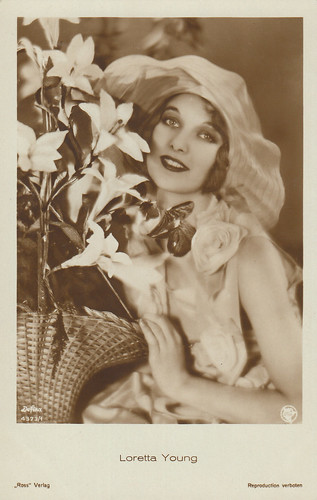
German postcard by Ross Verlag, no. 4373/1, 1929-1930. Photo: Defina / First National.
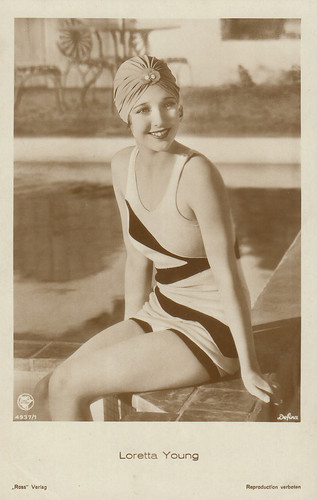
German postcard by Ross Verlag, no. 4937/1, 1929-1930. Photo: Defina / First National.
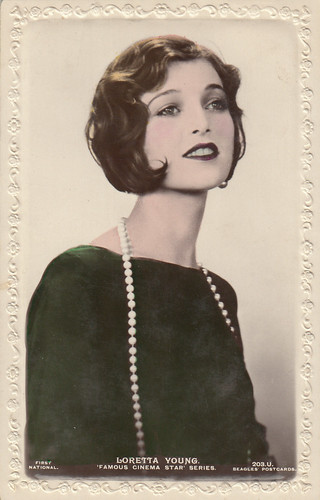
British postcard in the Famous Cinema Stars Series by Beagles, no. 203.U. Photo: First National.
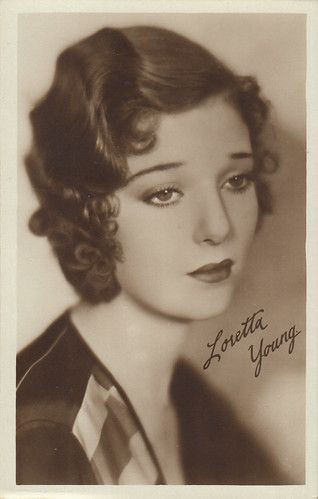
British postcard issued with Sarony cigarettes, no. 38 of a third series of 50 Cinema Stars.
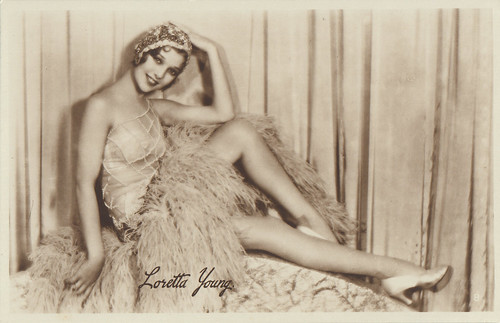
British postcard issued with Sarony cigarettes, no. 8 of a fifth series of 25 Cinema Stars.
A Hollywood child
Loretta Young was born Gretchen Young on the 6th of January 1913 in Salt Lake City, U.S.A.
She had two elder sisters who, as Polly Ann Young and Sally Blane, would also later become film actresses. In 1916, her father left the family and her mother relocated to Hollywood.
Soon, Gretchen began to appear as an extra in several movies. She played for example a fairy in The Primrose Ring (1917), a Mae Murray vehicle, or an Arab child in The Sheikh (1921).
Mae Murray was so taken with the young child that, knowing the Young family was struggling, she offered to take her into her home in 1918. Gretchen spent an enchanted time in Murray’s house. She was dressed in the finest clothes, was given dance lessons by famous choreographer Ernest Belcher and was spoiled by the actress. In March 1919, Mae Murray left California for New York and offered to take Gretchen with her but Mrs Young nixed the idea.
In 1954, Mae Murray, who had fallen into poverty, got in touch with Loretta Young and asked her for $5000, claiming it was to help friends in need. After she had received the money, Mae, who had stayed vague about where she then lived and how she could be reached, vanished from sight and never contacted Loretta again.
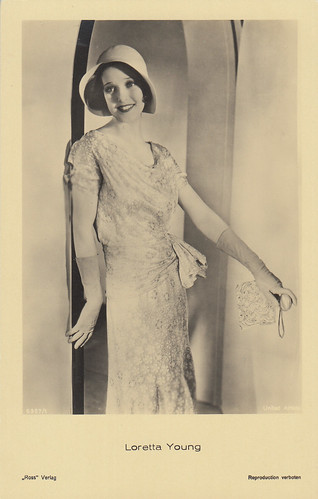
German postcard by Ross Verlag, no. 6957/1, 1931-1932. Photo: United Artists.

Argentinian postcard by F. Riudavets, Buenos Aires, no. 350. Photo: First National & Vitaphone Pictures.

British postcard in the Colourgraph Series, London, no. C80a. Photo: First National.

German postcard by Ross Verlag, no. 7960/1, 1932-1933. Photo: First National. Loretta Young as the Chinese character Sun Toya San in The Hatchet Man (William A. Wellman, 1932).
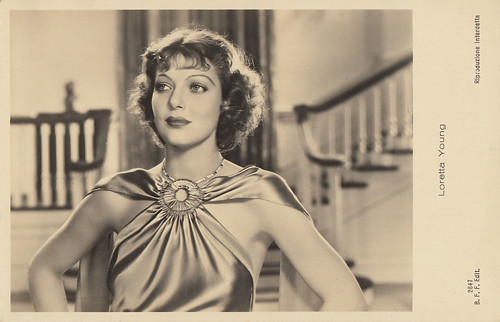
Italian postcard by Ballerini & Fratini, Firenze (BFF Edit.), no. 2847.
A quick climb to the top
After several years in school, Gretchen came back to the screen in a bit role in Naughty But Nice (1927). The star of the movie, Colleen Moore, was so impressed by the teenage girl that she urged First National to put her under contract, which they did. As her first name 'Gretchen' was thought of as sounding too harsh, she was rechristened 'Loretta'.
She got her first important role in Laugh, Clown, Laugh (1928), alongside Lon Chaney, and made her talking debut in The Squall (1929). First National very soon realized her potential and her career quickly took off.
The young rising star was submitted to a hectic filming schedule and was featured in movies such as The Girl in the Glass Cage (1929), The Fast Life (1929), The Careless Age (1929), Loose Ankles (1930), Road to Paradise (1930), Kismet (1930), The Devil to Pay (1930), Three Girls Lost (1931), Big Business Girl (1931), The Ruling Voice (1931), Taxi (1932), Play Girl (1932), Life Begins (1932), Zoo in Budapest (1933), Midnight Mary (1933), She Had to Say Yes (1933), Man’s Castle (1933), …

Italian postcard by Ballerini & Fratini, Firenze (BFF Edit.), no. 2848.
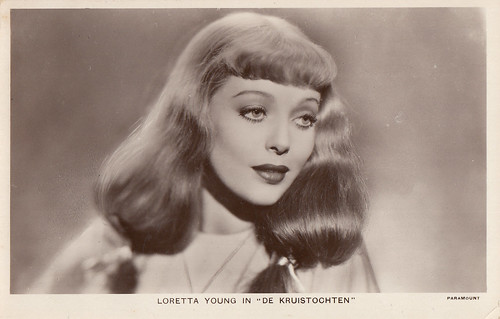
Dutch postcard by Bonnist & Zonen, Amsterdam, no. B425. Photo: Paramount. Loretta Young in The Crusades (Cecil B. DeMille, 1935).
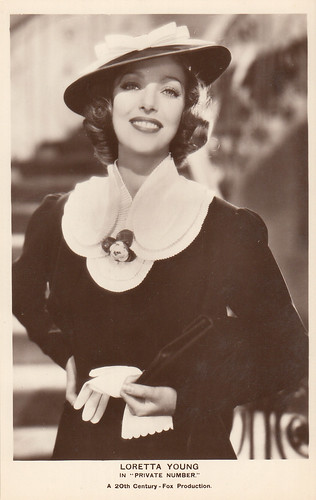
British postcard in the Picturegoer Series, no. FS26. Photo: 20th Century - Fox. Loretta Young in Private Number (Roy Del Ruth, 1936).
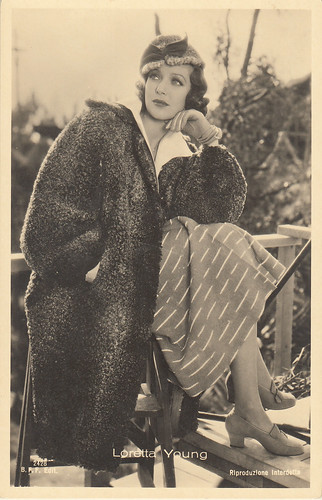
Italian postcard by Ballerini & Fratini, Firenze (B.F.F. Edit.), no. 2428.

Italian postcard by Ballerini & Fratini, Firenze (B.F.F. Edit.), no. 3945.
A new contract
In June 1933, she signed with Darryl Zanuck, who kept her very busy with an average number of four or five films a year. These include Born to Be Bad (1934), The White Parade (1934), Call of the Wild (1935), The Crusades (1935), Private Number (1936), Ramona (1936), Love Under Fire (1937), Three Blind Mice (1938), Kentucky (1938), …
She also formed a handsome movie couple with Tyrone Power in Ladies In Love (1936), Love Is News (1937), Cafe Metropole (1937), Second Honeymoon (1937) and Suez (1938).
Dissatisfied by the way she was being handled, she quit 20th Century Fox at the end of the 1930s.

Italian postcard by Ballerini & Fratini, Firenze (B.F.F. Edit.), no. 3673.
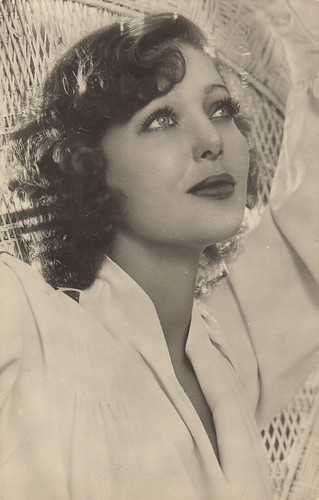
Spanish postcard no. 1087.
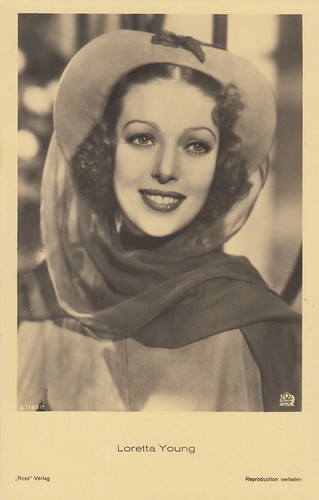
German postcard by Ross Verlag, no. A 1160/1, 1937-1938. Photo: 20th Century Fox.

Italian postcard by Ballerini & Fratini, Firenze (B.F.F. Edit.), no. 3605. Photo: 20th Century Fox. Loretta Young in Ramona (Henry King, 1936).

French postcard by A.N., Paris, no. 1165.
An unexpected Oscar in the 1940s
She was still in demand in the 1940s and notably starred in The Doctor Takes a Wife (1940), The Men in Her Life (1941), Bedtime Story (1942), A Night to Remember (1942), China (1943), And Now Tomorrow (1944), Along Came Jones (1945), The Stranger (1946), The Bishop’s Wife (1947), Rachel and the Stranger (1948), The Accused (1949), Come to the Stable (1949), …
During her film career, Loretta Young has never been ranked as one of the most outstanding actresses of her time and she often won more praise for her stylish beauty. She nevertheless won an unexpected Best Actress Oscar for The Farmer’s Daughter (1947), against the tough competition of Joan Crawford, Susan Hayward, Dorothy McGuire and Rosalind Russell.
She began the 1950s by co-starring with Clark Gable in Key to the City (1950) and by giving a good performance in the thriller Cause for Alarm (1951).
After the family-oriented comedy It Happens Every Thursday (1953), she wisely turned to television.
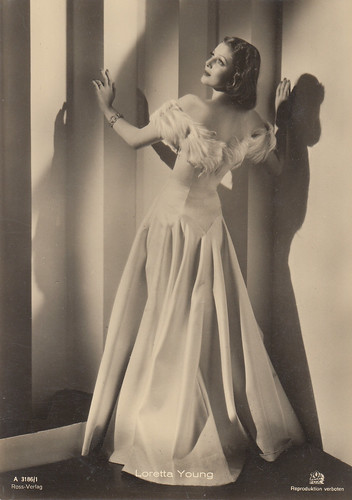
German postcard by Ross Verlag, no. A 3186/1, 1941-1944. Photo: 20th Century Fox.
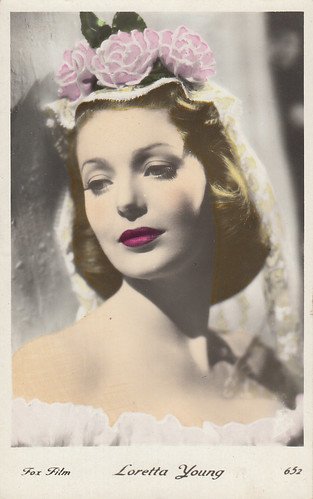
French postcard by Erpé, no. 652. Photo: Fox Film.
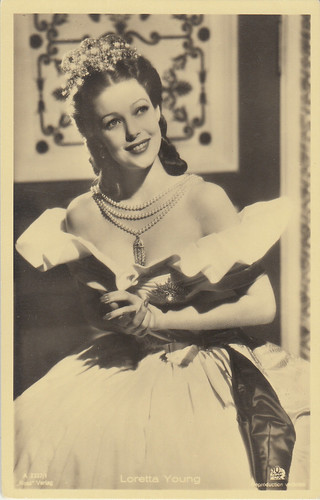
German postcard by Ross Verlag, no. A 2337/1, 1939-1940. Photo: 20th Century Fox. Loretta Young in Suez (Allan Dwan, 1938).
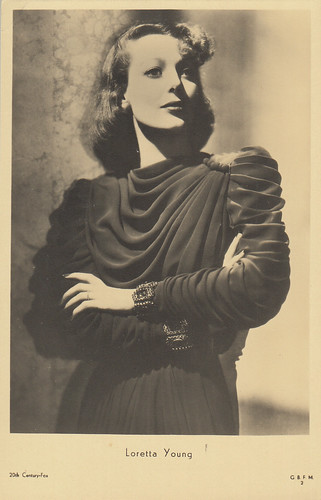
Italian postcard by G.B. Falci Editore, Milano, no. 2. Photo: 20th Century Fox.

British postcard by Picturegoer, no. FS194. Photo: 20th Century Fox. Loretta Young and Don Ameche in The Story of Alexander Graham Bell (Irving Cummings, 1939).
Loretta on TV
From September 1953 to June 1961, she hosted the very popular Loretta Young Show, which earned her three Emmy Awards in 1955, 1957 and 1959.
Each week’s episode began with a beautifully gowned Loretta making a spectacular entrance through a door and uttering a few introductory remarks about the topic of the day.
This glamourous opening segment was followed by a 27-minute comedy or drama. During the run of the series, she acted in about 65 % of these. For the remainder, roles were taken by other performers such as Laraine Day, Mercedes McCambridge, Teresa Wright, Merle Oberon, Dorothy Malone, Viveca Lindfors, Virginia Mayo, etc. Over the years, The Loretta Young Show also gave exposure to newcomers such as Sue Lyon, Dennis Hopper, Elizabeth Montgomery and Mike Connors.
From September 1962 to March 1963, she played a widow in The New Loretta Young Show, which was a flop. Afterwards, she mostly devoted herself to charities.
She came back to acting in two TV movies, Christmas Eve (1986), for which she was awarded a Golden Globe for Best Performance, and Lady in the Corner (1989). Loretta Young passed away on the 12th of August 2000.
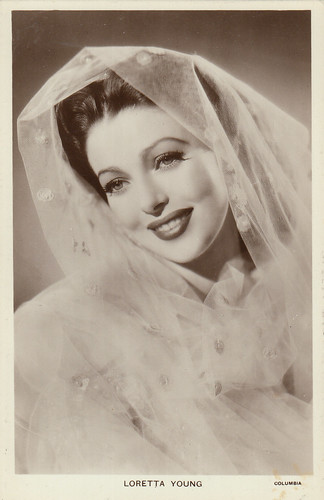
British postcard by Picturegoer, no. W14. Photo: Columbia.
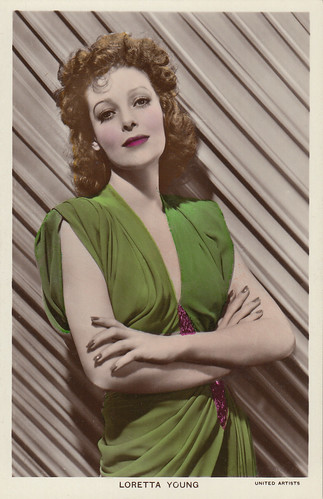
British postcard in the Colourgraph Series, no. C336. Photo: United Artists.

Italian postcard by Bromofoto, Milano, no. 291. Photo: Paramount Films.
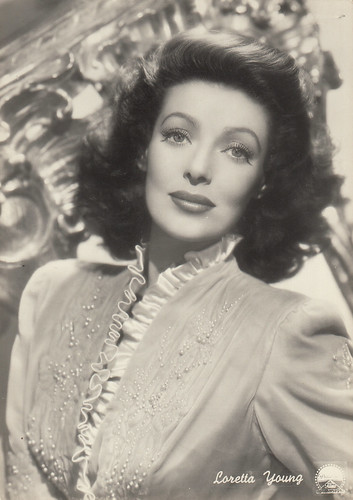
Italian postcard by Bromofoto, Milano, no. 345. Photo: Paramount.
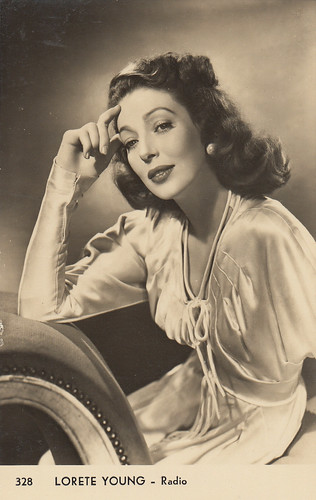
Spanish postcard no. 328. Photo: Radio.
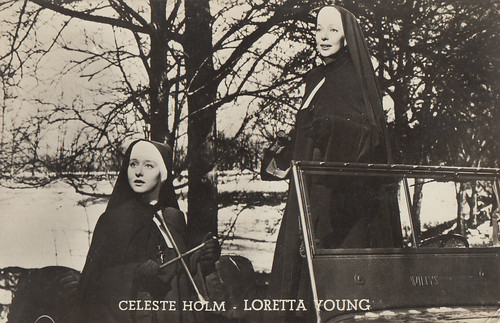
Vintage postcard. Loretta Young and Celeste Holm in Come to the Stable (Henry Koster, 1949).
Her private life
In January 1930, she eloped with actor Grant Withers and they married in Yuma. In less than a year, they separated and, in September 1931, she was granted a divorce.
During the filming of Man’s Castle (1933), she and her co-star Spencer Tracy fell in love. But he had a wife and, although they lived separately for many years, he stayed married to her until his death. After Loretta had realised that Tracy would not divorce and that their affair was leading nowhere, they separated.
In June 1937, she announced that she had adopted a baby girl, Judy, from a Catholic orphanage. In fact, she was the child’s biological mother and the father was her co-star in Call of the Wild (1935), Clark Gable, who was married at the time. A devout Catholic, she strongly objected to abortion. So, she secretly had given birth to Judy in November 1935, after having carefully hidden her pregnancy from the press. The baby was then placed in an orphanage until her so-called 'adoption'.
Young tried hard to keep the truth from her daughter. It was only at the end of the 1950s, when she was an adult, that Judy, to her shock, learned that she was her mother’s natural child and that her father was Gable. She nevertheless waited until the mid-1960s to confront Loretta, who confessed that she had lied to her daughter until then.
However, during her lifetime, the actress never publicly acknowledged the truth, even when, much to her chagrin, Judy published a book about her parentage in 1994. She took care that her authorised biography, in which she finally admitted the facts, was only published after her death.
In 1940, she married radio advertising executive Thomas H. A. Lewis. They had two sons, in 1944 and 1945, and they divorced in 1969. She remarried famous clothes designer Jean Louis in 1993 and was widowed in 1997.
According to Young’s daughter-in-law, Linda Lewis, Loretta had learned of the concept of date rape by watching a TV program in 1998 and allegedly told her that this applied to what happened between Gable and herself. Linda Lewis waited until Loretta and Judy had passed away to disclose her revelations in 2015.

Italian postcard by Rotalfoto, Milano, no. 337.

British postcard in the Greetings Series. Photo: Metro-Goldwyn-Mayer.
And a guilty pleasure...
The Loretta Young Show - a sample of Loretta's famous show opens. Source: The Loretta Young Show (YouTube).
Text and postcards: Marlene Pilaete.
No comments:
Post a Comment